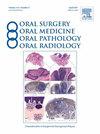Total Edentulism and Its Epidemiological Surveillance in Oaxaca, Mexico from 2009–2019
Oral surgery, oral medicine, oral pathology, oral radiology, and endodontics
Pub Date : 2021-12-16
DOI:10.3390/oral1040035
引用次数: 0
Abstract
Total edentulism is the loss of all teeth for any cause by a multifactorial process that involves biological and patient-related factors. Studies on edentulism and risk factors in Mexico are limited, and the epidemiological surveillance data is scarce and controversial since official governmental reports are not statistically representative of the country. We estimate the distribution for edentulism according to sociodemographic and socioeconomic variables in adults from a low-income state in 2003 and its progress in Mexico. We analyzed data from the National Performance Evaluation Survey in Oaxaca, Mexico, and the annual reports of the Epidemiological Surveillance System of Oral Pathologies in 2009–2019 using X2. Oaxacan patients older than 75 y.o. (17.9%, p < 0.05), those with lower schooling (11.2%), and diabetes (14.5%) presented the highest percentage of edentulism. We do not observe differences in edentulism between sex or residence (p > 0.05). From 2009 to 2019, country data reports the lowest rate of edentulism in adults over 20 y.o. (0.32%; 95% CI 0.18–0.48%) and the most affected population over 79 y.o. (7.29%; 95% CI 5.2–9.30%). As it is a cumulative phenomenon, it is necessary to establish better surveillance, prevention, and treatment programs to improve the oral health of older thus reducing edentulism.墨西哥瓦哈卡州2009-2019年全牙无牙症及其流行病学监测
全牙缺牙症是一种多因素的过程,包括生物因素和患者相关因素。在墨西哥,关于蛀牙症和危险因素的研究是有限的,流行病学监测数据是稀缺和有争议的,因为官方政府报告在统计上不能代表该国。根据2003年墨西哥低收入州成年人的社会人口学和社会经济变量,我们估计了无牙症的分布及其进展。我们使用X2分析了墨西哥瓦哈卡州国家绩效评估调查数据以及2009-2019年口腔病理流行病学监测系统年度报告。瓦哈卡州年龄大于75岁的患者(17.9%,p < 0.05)、受教育程度较低的患者(11.2%)和糖尿病患者(14.5%)患全牙症的比例最高。我们没有观察到性别和居住地之间的牙切性差异(p > 0.05)。从2009年到2019年,国家数据显示,20岁以上成年人的蛀牙率最低(0.32%;95% CI 0.18-0.48%), 79岁以上人群受影响最大(7.29%;95% ci 5.2-9.30%)。由于它是一个累积现象,有必要建立更好的监测,预防和治疗方案,以改善老年人的口腔健康,从而减少蛀牙。
本文章由计算机程序翻译,如有差异,请以英文原文为准。
求助全文
约1分钟内获得全文
求助全文
来源期刊
自引率
0.00%
发文量
0
审稿时长
1 months

 求助内容:
求助内容: 应助结果提醒方式:
应助结果提醒方式:


